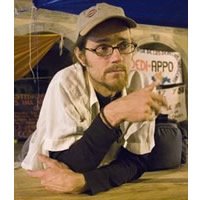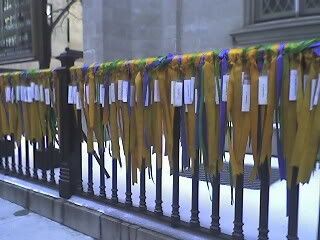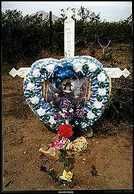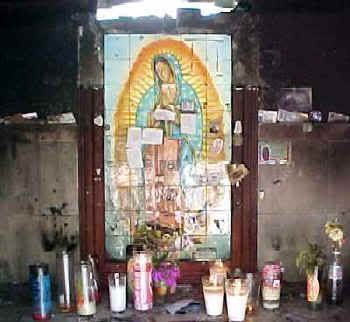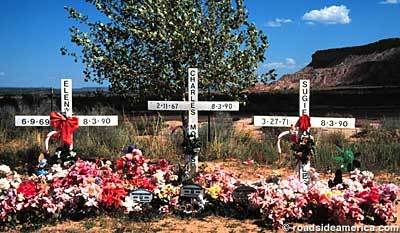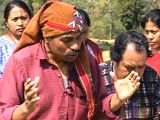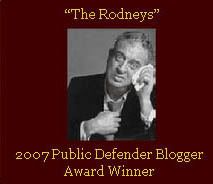 Jarvis Jay Masters
Jarvis Jay MastersOn Saturday there was dramatic news about a 22 year old California death penalty case. According to the
San Francisco ChronicleThe California Supreme Court, in an unusual step, has ordered state prosecutors to respond to defense lawyers' claims that new evidence shows a San Quentin State Prison inmate is innocent of the 1985 murder of a prison guard that sent him to Death Row.
Jarvis Masters' appeal is still a longshot in a court that upholds more than 90 percent of the death sentences it considers. But the circumstances of the Feb. 14 order signed by all seven justices have given Masters' lawyers a glimmer of hope that their 45-year-old client will be vindicated.
The order was "unique and breathtaking in its scope," said Joseph Baxter, one of Masters' appellate lawyers.
I've known Jarvis for years and corresponded with him. We share interests in Buddhism and writing and the law. I'm not his lawyer. I'm delighted with Saturday's news. I'm writing this diary because I want all of us to know about Jarvis, and because I would like all of us to oppose not only his execution, but all others as well.
There are several parts to this story. If this seems long, I apologize in advance.
First, there is the 1985 crime for which Jarvis was sentenced to death in 1990 and which has kept him on death row for 22 years. In 1985, Jarvis was 22 and serving a sentence for robbery. According to the
ChronicleMasters was in prison for armed robbery when he was accused of conspiracy and murder in the death of a San Quentin guard, Sgt. Dean Burchfield, 38. Burchfield was stabbed with a prison-made knife in June 1985.
Prosecutors said the slaying was ordered by the Black Guerrilla Family, a prison gang to which Masters belonged. Two other members were convicted and sentenced to life without parole. Masters -- who prosecution witnesses said took part in the planning, sharpened the knife and gave it to the inmate who stabbed Burchfield -- was sentenced to death.
In other words, the person convicted of the stabbing received a lighter sentence than Jarvis, who was on the 4th tier of the prison, when the stabbing occurred on the first tier. And there are legal problems with the death penalty because Jarvis was not the "stabber." Regardless, even the conspiracy to murder case against Jarvis has since fallen into rubble.
According to the
ChroniclePapers filed with the court by Masters' lawyers include statements from three fellow inmates who testified against him at trial and in the penalty phase, recanting their testimony. His co-defendants also submitted statements saying Masters had not been involved in the murder.
One inmate who testified that Masters had helped plot the killing, Bobby Evans, said in his statement that he had been promised a break in his sentences for attempted robbery and a parole violation, contradicting his trial testimony that he had not been offered leniency. Another inmate, Johnny Hoze, who testified that Masters had fatally stabbed another prisoner in 1984, said in his statement that he had lied because he held a grudge against Masters.
The prosecution's key witness, Black Guerrilla Family leader Rufus Willis, was granted immunity and testified that Masters helped plot the killing and wrote self-incriminating notes about his role. In his statement disavowing his testimony, he said a prosecutor threatened to return him to San Quentin if he didn't cooperate, which he said would have amounted to a death sentence because he had been identified as an informer.
Prosecutors knew about the flaws in their case but hid them from Masters' trial lawyers and the jury, defense lawyers said.
So what else is new, especially in death penalty cases? This case has flaws that tend to lead to exonerations: jail house testimony, promises of leniency for incriminating testimony, hidden promises to witnesses from law enforcement. And the Court in February seems to have recognized this and Jarvis's possible innocence in its order.
But that's just the first part of why I'm writing this diary. Jarvis wrote a book,
Finding Freedom,that is absolutely a must read to understand what long term incarceration is all about. He writes with amazing force. Some of the short stories in the book make me cry. Jarvis's insights are tempered by his practicing Buddhism for about 20 years while incarcerated, which is no easy task.
How did Jarvis ever become a Buddhist and nonviolent? He was introduced to Buddhism by Melody Ermachild, who was working on his case as an investigator, and who arranged for an
empowerment ceremony to be conducted at San Quentin by Chagdud Rinpoche. Since then, Jarvis has been a
practicing Buddhist. According to
Pema Choedron, who is one of America's best known Buddhist teachers, and is one of Jarvis's principle teachers
"Jarvis is an easy man to respect and an easy man to love. What I learn from him all the time is what it really means to keep one's vows of not harming and of helping other people in whatever ways one can. I always think, 'If Jarvis can do it in those most challenging and difficult situations, I can do it too.' It is a continual aspiration from my heart that Jarvis Masters not be killed and that I have the pleasure of knowing him as a free man; a free man who I know will benefit all the people he encounters."
But there's much more to this. This isn't a diary about a jailhouse conversion. It's more about our connection to this man.
Several years ago, I was traveling in India and Nepal with my middle son. Among other things, we visited important Buddhist sites, including Bodhgaya, where the Buddha 2500 years ago reached his enlightenment. The story is that the "tree of enlightenment" in Bodhgaya now is the decendent of the very Pippa tree the Buddha sat under. While we were standing under the revered tree-- it has been partially painted in gold leaf-- some leaves fell to the ground. I picked them up and put them in my pocket. Later, I realized that I wanted to send one of them to Jarvis, because I was thinking about him and thought it might be of help to him.
When I returned to the US, I sent Jarvis the leaf. But after I mailed the leaf, I was stricken with doubt. Would San Quentin confiscate the leaf and throw it in the garbage? Would Jarvis actually receive it on his most segregated part of death row? Would it be contraband? Would guards defile the leaf or mock Jarvis for receiving it? Eventually, I stopped thinking about the leaf because I realized that I had two others I could send if the first one didn't arrive.
About three weeks later, I got a note from Jarvis thanking me for the leaf, that he had received it. I was extremely happy about this. I liked thinking about how the leaf of the tree of enlightenment had made it all the way to San Quentin's death row.
So now when I think about this man I think about him as a point on a triangle. There's his point, stuck deep in San Quentin's death row, where he has the leaf of the enlightenment tree and can use it however he finds helpful. And there's a point in Bodhgaya, which is connected to embodying with every breath nonviolence and compassione and helping others. And then there's the third point, which is me, and if you've read this far, you, who recognize that Jarvis shouldn't be killed, and that the death penalty must be abolished.
If you want to, you can write to Jarvis:
Jarvis Jay Masters
C35169
San Quentin State Prison
San Quentin, California 94974.

